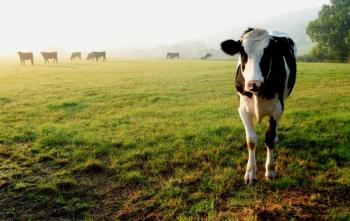
Fluid therapy in small ruminants (Proceedings)
Information on fluid therapy in sheep, goats, llamas, alpacas, crias, and lambs.
Basics
Catheters
Adult sheep/goats/llamas/alpacas and crias: 16 G 3.25" in jugular
Kids/lambs: 18G 2" in jugular
Intraosseous in neonates if can't get catheter in
Always make stab incision completely through skin with #15 blade, will save time and catheters
Dehydration deficit
BW(kg) x %dehydration = deficit in liters (careful with small ruminants)
ex. 40 goat that 8% dehydrated needs 40 x .08 = 3.2 L
Maintenance
1 ml/lb/hr
Bicarb deficit
Neonate: BW(kg) x base deficit x .6 = mEq bicarb
Adult: BW(kg) x base deficit x .3 = mEq bicarb
Can substitute (normal bicarb - measured bicarb) for BD
mEq bicarb/12 = grams bicarb
Lambs and Kids
Following dystocia
(may look normal initially, but crash 2-4 hours later, be aggressive in therapy)
If depressed: Measure bicarb and correct deficit or use BD of 10
Consider SoluDelta-Dortef (1 mg/lb)
Consider oxygen even if no respiratory difficulty and normal color
Dehydrated non-diarrheic (septic, hasn't nursed, etc.):
May be hypoglycemic
If < 8 % dehydrated, mild depression, still walking:
150-250 mls oral calf electrolytes without bicarb
If > 8% dehydrated, depressed, recumbent:
Correct fluid deficit with balanced electrolyte solution
Add: 20 mEq KCl/L and 20-40 mls 50% dextrose/L (will = 1-2% dextrose in solution)
OR
4 ml/kg hypertonic saline solution (administer over 5 min) followed by oral calf electrolytes without bicarb
- if no response consider acidosis and treat like dystocia above
- may need more glucose if severe hypoglycemia
- follow up with milk
Diarrhea:
dehydrated, acidotic, hyperkalemic, whole body depleted in K+ (not usually hypoglycemic)
For deficit:
If < 8 % dehydrated, mild depression, still walking:
150-250 mls calf electrolytes without bicarb (if available, if not use with bicarb)
If > 8% dehydrated, depressed, recumbent:
bicarb: calculate bicarb needs if blood work available or use BD of 10
8% bicarb = 1 mEq/ml
fluid: make up fluid deficit with balanced electrolyte solution
add: 20 mEq KCl/L and 20-40 mls 50% dextrose/L (will = 1-2% dextrose in solution)
give half first hour then other half over 2 hours
OR
4 ml/kg hypertonic saline solution (administer over 5 min) followed by oral calf electrolytes with bicarb
(do not use HSS if suspect mixing error of oral electrolytes administered by owner)
- follow up with oral calf electrolytes without bicarb (if available, if not use with bicarb) per day as long as severe diarrhea continues
- leave on milk or milk/milk replacer unless chronic diarrhea and use of TPN
- always mix electrolytes according to directions with water, not milk
- always refrigerate calf electrolytes that go unused and discard after 3 days
Adults
usually alkalotic, mild hypokalemia, mild hypocalcemia
If < 8 % dehydrated, mild depression, still walking:
correct deficit with oral fluids unless rumen disease or GI obstruction
can add KCL and calcium gel to oral fluids
If > 8% dehydrated, depressed, recumbent:
IV isotonic fluids with 20 mEq KCl/L and calcium solution at 25-50 ml/L
OR
- 4 ml/kg hypertonic saline solution (~ 2 L per adult cow) administer as fast as possible through 14 G catheter
- follow with oral fluids (will usually drink following HSS) if no GI disease or IV if GI disease
If grain overload:
- calculate bicarb deficit if blood work available or use BD of 10 and administer IV
- follow up with IV fluids (do not give large amounts of oral fluids, already have rumen distension)
- can give some bicarb orally but probably no use if severe (need rumenotomy)
- DO NOT USE hypertonic saline solution (may be already hyperosmolar)
Llamas/Alpacas
- unpredictable electrolyte and acid/base status so always run bloodwork, esp. in crias
- adults get fatty liver commonly when off feed so consider PPN if anorexic for more than a few days
- camelids get hypoproteinemic easily
TPN/PPN
- use formula in back of Smith Large Animal Internal Medicine
- for neonates use TPN
- for adults use PPN since fatty liver is a concern if negative energy balance (just leave out lipids in formula)
- start at 1/4 target rate (in Smith under formula), if glucose 150-200 in six hours leave at current rate, if > 200, slow rate slightly, if < 150, increase rate by another 1/4 (these are basic rules, try not to change rate drastically and give them time for insulin to increase
- keep increasing until get to target rate (I have never gotten to target rate, but always see benefits even at low rate)
- monitor glucose/PCV/TP q 6 hours, electrolytes/acid/base status daily (watch out for hypokalemia)
- wean off slowly
- MUST BE administered with fluid pump
OR
- for adults
- 5L normosol + 500 ml 50% Dextrose + 1 Liter Aminosyn + K and Ca as needed + 20 ml B vitamins at rate of 5% body weight per day
Insulin is recommended in camelids with TPN or above fluid regimen (0.4 u/kg ultralente SQ q24hrs). Stop insulin 24 hours before stopping fluids.
Tips
If on continuous fluids consider bolusing q 3 hours. (have better control of rate in animals with long necks and thick skin that cause kinking of catheters)
NOT appropriate if glucose content is > 2% or for PPN/TPN
- 1 level teaspoon is approximately 5 grams of most salts
- NaHCO3: 1 gm = 12 mEq so 240 mEq = 20 grams or ~ 4 tsp.
- Isotonic saline: 9gms/L non-iodized table salt,
- 2 tsp NaCl/L water is isotonic saline
- Supplement potassium:10-20mEq/L or 1gm/L(14mEq/L)
- half a tsp. lite salt/L water (lite salt is half sodium chloride and half potassium chloride)
Newsletter
From exam room tips to practice management insights, get trusted veterinary news delivered straight to your inbox—subscribe to dvm360.





